The Dragon Boat Festival - Feasting on my own Zongzi (Glutinous Rice Balls wrapped in leaves)!
Dear Steemit Friends:
Today is a special day, can you guess why? Other than being the last day of May, it's also a traditional holiday in China. This holiday is known as the Dragon Boat Festival, or in Chinese, known as the Duanwu Festival. A friend of mine messaged me to ask about this festival, wanting to know more about it's background story. So, today I'm going to share this culturally significant day with everybody and explain a little more about why Chinese people celebrate it.
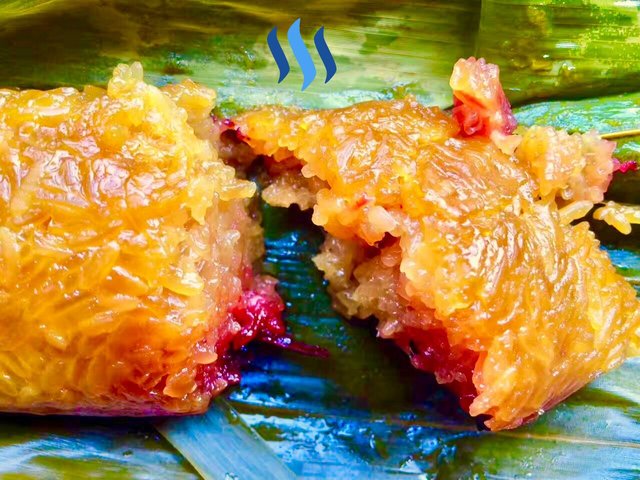
The Dragon Boat Festival, Spring Festival, Ching Ming Festival and Mid-Autumn Festival are known as the four main Chinese traditional festivals. In 2009, UNESCO formally inducted the Dragon Boat Festival into it's list of world intangible cultural heritages. This marked the first Chinese festival to be included in this prestigious list.
The Dragon Boat Festival occurs on the 5th day of the 5th month of the Chinese lunar calendar. Because the Chinese calendar is lunisolar, the date of the festival changes each year on the western Gregorian calendar. This year, it happened to fall on May 30th.
There are many traditions that have spawned from this particular festival, but the most well known story is that of Qu Yuan, an accomplished poet. Aside from being a distinguished poet, Qu Yuan was also a minister of the Chu Royal House. During the Warring States period of the Zhou Dynasty, he was in opposition to the alliance between Chu and Qin. As a result, he was banished from Chu and spend the next several decades writing some of his best poetry. Twenty eight years later, the Qin and Chu alliance had dissolved and eventually led to the capture of Ying (the Chu Capital) by the Qin.
Devastated, Qu Yuan threw himself into the Miluo River, committing suicide by drowning.
The local people very much admired Qu Yuan, and tried their best to save him by racing out in their boats. This is how the Dragon Boat races became a tradition. When the boats could not find his body, it is said that the locals dropped balls of sticky rice wrapped in leaves into the river so that the fish may eat them instead of Qu Yuan's body. These balls of sticky rice are known today as Zongzi.
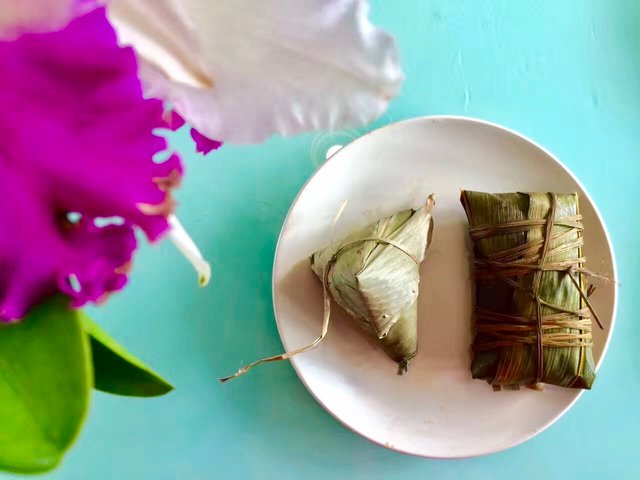
Eating Zongzi on this festival represents a number of positive moral constructs in addition to good luck. The Zongzi characters are similar in sound to another word - Neutron. In Chinese, it is the forbearer of good luck with regards to child birth. Another interesting homonym is Gaozi which means to pass brilliantly, referring to good academic results. As you can see, eating Zongzi carries many auspicious benefits to the Chinese people, bringing plenty of luck in times of need.
To get my own fair share of this auspicious luck, I decided to cook my own zongzi with friends.
Below, let's take a look at how I made them!
Zongzi have been around as early as the Spring and Autumn period (770 - 476 BC). Back then, it was used as a form of offering to honour one's ancestors. It is essentially a glutinous rice dumpling wrapped in leaves. By the Jin dynasty (265 - 420 AD), it became the official celebratory food of the Dragon Boat Festival. This tradition can be found outside of China too. People in Japan, Vietnam, Singapore, Malaysia, Burma and pretty much any country with a large oriental population will eat Zongzi as well as celebrate this festival.
In China, Zongzi can be differentiated by whether it is made in the north (sweet), or in the south (salty). In the north, the Zongzi is sweet because they use dates inside the glutinous rice and also because the northern people like to dip their rice balls in sugar sauce. In the south, people prefer to eat their Zongzi with soy sauce and therefore a more salty taste. In the south, they usually use various meats, hams and egg yolk as the stuffing.
Personally, I prefer a sweeter tasting Zongzi.
The main process of preparing the Zongzi is as follows:
- Soak the Glutinous Rice
- Wash the Zongzi leaves
- Wrap the rice ball
Usually both the leaves and the glutinous rice must be soaked in water for at least two hours.
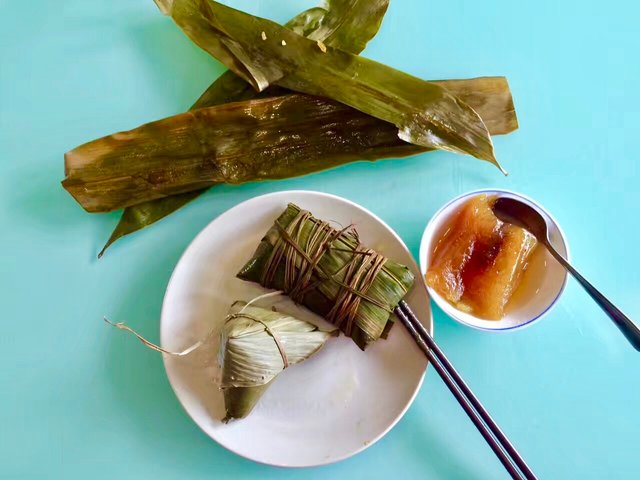
To wrap the rice ball, take two leaves and arrange them slightly criss crossing each other, then take the soaked glutinous rice ball and place in the middle. Then form a conical wrap around the rice ball.
Sometimes you'll see Zongzi in the shape of a prism. The idea is the same.
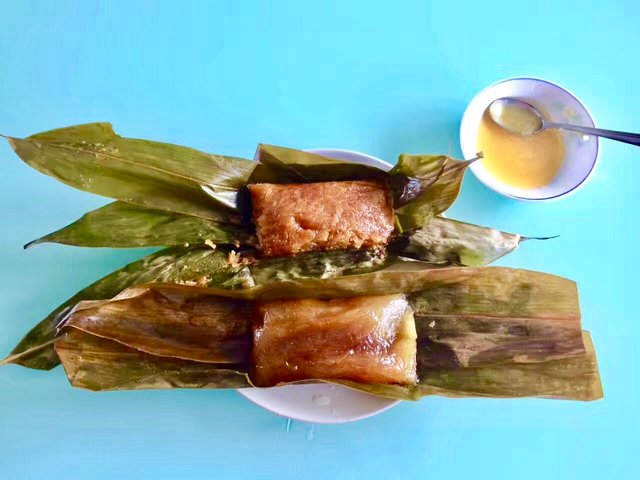
Once wrapped, use some rope to tie up the Zongzi and then put it in a pressure steam cooker.
This is what the rice looks like beforehand.

This is the rice after steaming.

After steaming, you may then unwrap the Zongzi and let the exotic odours assail the nostrils.
Cutting open the rice ball, you can see this one I made with blueberry stuffing.
Each rice ball is soft and fragrant, it's colour and lustre are sparkling and translucent, pure and limpid.

The zongzi tastes a little spongy with a mix of sweet and sour flavours. Absolutely delicious!

After all of that, are you guys hungry yet? Hopefully you've understood a little more about the background story of the Dragon Boat festival, and also discovered a new kind of food to try.
Hope you enjoyed my creations!
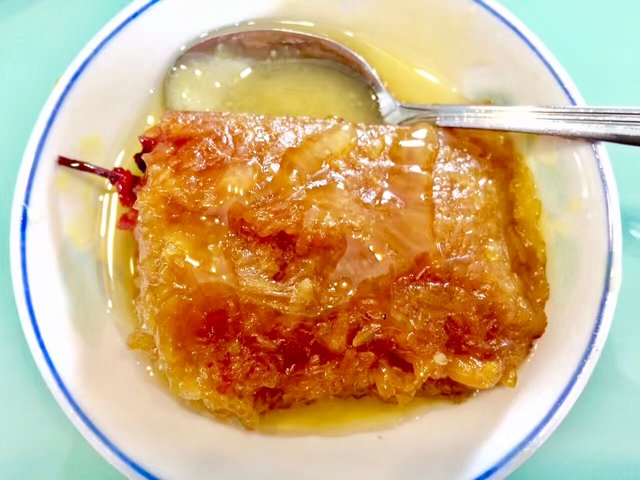
今天是中国传统的端午节,首先祝steemit的朋友端午节快乐。之前有朋友私信我说,想了解一下中国端午节的文化,听听端午节的故事,今天我就带大家了解下中国人眼里的端午节文化。端午节与春节、清明节、中秋节并称为中国民间的四大传统节日。2009年联合国教科文组织正式审议并批准中国端午节列入世界非物质文化遗产,因此端午节成为中国首个入选世界非遗的节日。
端午节是每年农历的五月初五,它中国古老的传统节日,始于春秋战国时期,至今已有2000多年历史。关于端午节的起源,民间最普遍流传的一种说法是,是为纪念历史上伟大的诗人屈原,屈原是战国时代的楚国人,他为人正直,忧国忧民,一心想让国家变得强大,i结果却屡屡遭到小人算计,楚王怀疑,最终在悲愤绝望中于五月初五投汨罗江而死。后来民众为了纪念它,才有了端午节和民间的纪念习俗,这些习俗起源于中国大陆南方江浙地区,主要的习俗就是吃粽子和赛龙舟。赛龙舟是团体活动,并不是每个人都能参与,但是包粽子吃粽子的习俗可谓是家喻户晓,“吃货国”人人都能参与。
端午节这天吃粽子在中国是有很好的寓意,粽子和中子同音,是喜得贵子之意,也有高中的意思,能够提升学业和考试的运气。所以吃粽子成了人们对生活美好的期望,能够给人们带来好运。今天我也空出时间和朋友做了一回粽子,下面就来和大家分享下做粽子的过程吧。粽子是粽叶包裹糯米蒸制成的一种专门庆祝端午节的食物,粽子早在春秋时期就出现,当时是用来祭祖和神灵。到了晋代,粽子成为端午节庆食物。在日本、越南以及华人聚居多德新加坡、马来西亚、缅甸等地方也有吃粽子的习俗。
在中国,以北方和南方为代表的粽子也有甜和咸的区别,北方以多甜粽,很小的枣粽为主,并且喜欢蘸白糖吃;在南方大家喜欢酱油味,习惯吃咸的粽子,例如鲜肉、火腿、蛋黄等作为馅料。因为我个人偏爱甜糯米,所以今天我选择做一碗甜粽子。
主要过程大概是:
浸糯米
洗粽叶
包粽子
粽叶和糯米都要洗干净后用水泡软,糯米至少要泡两小时以上。
取两片粽叶,交叉叠起,把泡好的长方形糯米放进来,从中间卷起成圆锥状或者依照糯米本身的形状自由发挥。
包好后用绳捆起来,放在高压锅,加水蒸粽子。这是蒸之前。蒸之后。
粽子蒸好后打开来,香味扑鼻,从中掰开来看看,没错这是我自创的蓝莓馅的粽子,每一颗糯米都被蒸的又软又香,色泽晶莹剔透的。吃起来是松软的糯米带着酸甜的水果口味,好吃极了。看了这个,你们有没有肚子饿呢?看了这个,你们是不是对端午节文化有了更深刻的了解呢,也希望你们喜欢我分享给你们的亲手独创的粽子。
In all your travels, where do you find gold is the most desired?
Seems like Thailand..
Thank you. Good to know
leh min ho
These look delicious.
thank you, i should start my career as a chef :)
Do it. Always follow your passions. :)
祝大家端午节快乐!Happy Duanwu festival!
Yay, happy dragon boat festival!!
That looks deelish sweets
thanks! I was impressed with myself haha :D
I wanna be like you when I grow up lol.
This like a "Timpham" in my country!!!
which country are you from?
Aceh!!!
Those look scrumptious! I see the similarity!
Yes, we have a similarities
I like a lot your travels, congratulations for these photos!
Thank you! :D Not so much a travel post as it is a food and culture one.
I love asian food, japanese and thai are my favourite
Mmmm ... this looks good...
What do you think about this dish?
https://steemit.com/food/@kleryk200/chopped-cutlet-with-melting-camembert-and-blueberry-jelly
Looks incredibly rich! Upvoted :D
Thank you so much.It's important for me)))
爱你爱你爱你
Remember to use 妳 instead of 你 when referring to a girl :)
,,,
听妳的
爱妳爱妳爱妳∩_∩
I know a lil bii about the festival, they have it out here in colorado, but with all these tasties you enjoy around the world how do you stay so slim huh? Maybe just natural high metabolism? :)
You must have a reasonably sized asian population in Colorado!
As for me, well, I guess i'm taking advantage of my high metabolism whilst I can, I suspect i'll start going down hill once I hit my 30's!
Looks Good @sweetsssj , but a lot of work?
How long does it take to make?
With the soaking period I would say about 3 hours in total!